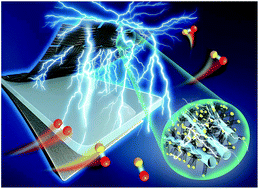Self-supported N-doped CNT arrays for flexible Zn–air batteries†
Abstract
The exploitation of flexible and rechargeable energy storage devices is crucial for meeting the requirements of the next generation of electronic products. Herein, we report a novel method to grow N-doped carbon nanotube (NCNT) arrays with encapsulated CoFe alloy nanoparticles on carbon fiber cloth (CFC) as a self-supported air cathode for flexible ZABs. The optimized electrode exhibits superior bifunctional activities with a half-wave potential of 0.873 V for the oxygen reduction reaction (ORR) and a potential of 1.506 V for the oxygen evolution reaction (OER) at 10 mA cm−2, greatly superior to that of 20% Pt/C for the ORR and IrO2 for the OER, respectively. The experimental results demonstrate that the atomically dispersed Co(Fe) dual-sites formed in the NCNT walls are key to the excellent activities of the self-supported electrode. When the self-supported electrode is applied as an air cathode for flexible solid-state ZABs, a large open-circuit voltage of 1.426 V, a high initial energy efficiency of 69% and a large power density of 37.7 mW cm−2 as well as robust stability are achieved. Furthermore, the solid-state ZABs with the self-supported electrode exhibit excellent flexibility even under extreme bending conditions. Our strategy presented here opens a new way for bifunctional catalysts for high-performance flexible ZABs.



 Please wait while we load your content...
Please wait while we load your content...